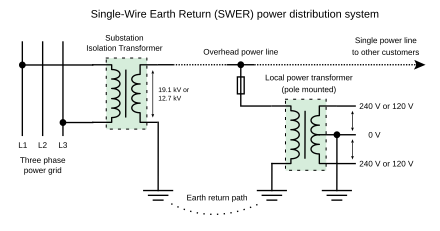Single-Wire Earth Return
The English term Single-Wire Earth Return (abbreviated SWER ) is understood in electrical power engineering as a form of power grid which is used to supply electricity to large, rural areas and is characterized by particularly low costs. This form of implementation is used in rural regions such as Australia , New Zealand , North America such as Canada , Brazil , India and individual countries in Africa such as South Africa and Mozambique . In Europe, this form of electrical energy supply can be found in Iceland, where remote hamlets are supplied in this way. In the rest of the more densely populated Europe, three-phase alternating current is continuously available right up to the end customer.
construction
The SWER system represents a single-phase three-wire network on the low-voltage side to the customer connections , as it supplies single-phase alternating voltage and not three- phase alternating voltage . As an essential feature at the medium voltage level, it uses only one electrical conductor, typically implemented as an overhead line , and grounding as the operational return conductor . This makes the construction of these supply lines particularly cost-effective, since at least three conductors have to be laid in three-phase networks. Since the earth electrode carries operational current on the high-voltage side, the main disadvantage of SWER networks is the guarantee of a low earthing resistance necessary for operation . In Australia, in the so-called outback , SWER networks have spatial dimensions of up to 300 km per segment, which is roughly ten times the size of the medium-voltage networks common in Central Europe.
In Australia, the transformers used within the framework of SWER are specified in the Australian standard AS2558–2006.
The single-wire earth return is fed in the regional substations from the higher-level voltage levels , which are consistently constructed as a three-phase system, by means of special single-phase isolating transformers with powers of a few 100 kVA up to a few 1 MVA per string, as shown in the adjacent figure. The voltages on the high-voltage side are 19.1 kV or 12.7 kV , depending on the region . This single-phase AC voltage is conducted to the local transformer stations , which in those regions are typically designed as mast transformers. This local transformer supplies the single-phase three-wire network and generates the low voltage intended for the end customer of two times 240 V (e.g. in Australia ) or two times 120 V (e.g. in Canada ). Larger consumers such as air conditioning systems are switched on the low-voltage side between the two outer conductors, which results in double the voltage.
disadvantage
In addition to the problem of ensuring an electrically conductive earth connection, SWER, as a distribution network for single-phase alternating voltage, does not have a rotating field . This means that powerful electrical machines, such as the asynchronous motor , cannot be operated directly on the mains and require additional frequency converters or the Steinmetz circuit, which has disadvantages . On the other hand, single- phase asynchronous motors such as capacitor motors , AC motors and shaded-pole motors can be used without any problems, but have only low power. Furthermore, due to the principle involved, the losses in a single-phase network are higher than with the same material input in a comparable three-phase network. Due to the large expansions, there are still major fluctuations in the mains voltage at the end customer connections. In some cases, special regulating transformers have to be used for compensation.
Furthermore, the SWER increasingly leads to unbalanced loads on the superordinate three-phase network and thus instabilities in the electrical power network, since the division can only take place in the large blocks of a SWER line on a single phase of the three-phase network. The possibility of compensating for simple earth faults that typically occur in overhead lines without a power failure, for example within the scope of earth fault compensation , is also not possible in the SWER: If there is an earth fault in the conductor, an electrical short circuit and the resulting power failure are immediate consequences.
Similar uses of this concept
In the case of monopolar high-voltage direct current transmissions (HVDC) such as the Baltic Cable , the earth electrode is also used as a return line. There are no other similarities to the SWER system. The power supply for the Strausse ferry also falls into this category.
literature
- The Electricity Authority of New South Wales (Ed.): High Voltage Earth Return Distribution for Rural Areas . 4th edition. 1978.
Web links
- Single-Wire Earth Return FAQ , Rural Power, accessed on September 20, 2010
Individual evidence
- ↑ Single-Wire Earth Return (PDF; 1.6 MB), course templates Stonepower , (English)
- ↑ Single Wire Earth Return for Remote Rural Distribution ( page no longer available , search in web archives ) Info: The link was automatically marked as defective. Please check the link according to the instructions and then remove this notice. , by Conrad W. Holland, Maunsell Ltd., New Zealand, 2008, (engl.)
- ↑ AS2558-2006 ( Memento of the original from September 28, 2007 in the Internet Archive ) Info: The archive link was inserted automatically and has not yet been checked. Please check the original and archive link according to the instructions and then remove this notice. , Transformers for use on Single-Wire Earth Return Distribution Systems, published by Standards Australia, 2006, ISBN 0-7337-7326-5 (English)

